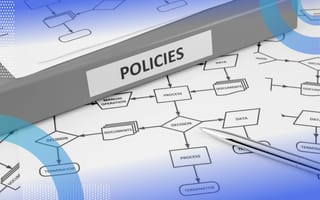While cybersecurity was everyone’s favorite topic in 2021 — and not necessarily for great reasons — so far, 2022 is the year of security compliance. With hyper-growth brands looking to sign new deals, expand into new markets, or go public, companies are increasingly looking for a way to leverage compliance as a business accelerator. At the same time, compliance leaders are leaning ever more heavily on automation to streamline their efforts. The real data that modern compliance tracks makes it an essential part of any growth strategy by:
3 Trends in Data-Driven Compliance Activity
- Using data-driven methods that quantify risk, to enable stronger integrated risk management (IRM);
- Replacing compliance-as-an-afterthought with compliance-shifted-left, to form an integral part of the business fabric; and
- Replacing the focus on checking the right boxes with a proactive stance that encourages business growth.
1. Compliance and Integrated Risk Management
Businesses are using cybersecurity and risk quantification tools to produce essential, measurable data to make better business choices.
The Concept: Compliance leaders were too often relegated to the sidelines. But it was only a matter of time before the right tools were available to highlight the value compliance could bring. Now, we’re there, with the growing fusion of governance, risk, and compliance (GRC) with cybersecurity and risk quantification tools. Determining how much to spend on risk reduction requires a clear view of a business’s overall risks and a valid way to measure them. With the availability of data-driven compliance tools that automatically pull risk-related data directly from sources, plus better models such as quantitative risk modeling and statistical modeling to accurately predict the potential cost to the business, cybersecurity and compliance are being recognized as integral to helping businesses make better risk management decisions.
The Advantage: The data resulting from compliance automation lets businesses precisely and reliably measure potential costs of risk and, therefore, enables them to determine with greater assurance how much to spend on a solution. Thus, fusing GRC with cybersecurity and leveraging risk quantification helps avoid losses from underspending on security and the waste from overspending.
2. Compliance Shifted Left
Businesses increasingly integrate compliance into the business fabric as a continuous, ever-present process.
The Concept: Traditionally, compliance activities were viewed as something to be dealt with only when necessary. When audit time came around, for example. Or when wooing new investors or trying to close a deal. But we’re seeing 2022 as the year when compliance is increasingly recognized as a driver of growth. That’s why more businesses are prioritizing compliance at the outset — or “shifting compliance left,” earlier on the project timeline — by implementing new models such as policy-as-code and embedding compliance controls into the business’s cloud security posture. They are injecting security and compliance into the fabric of the business as an ever-present component of all business processes.
The Advantages: Shifting compliance left helps businesses by:
- Reducing friction: A continuous approach makes compliance an everyday goal that business stakeholders become accustomed to helping achieve.
- Saving resources: By identifying vulnerabilities earlier through continuous testing, businesses save time and money
- Fostering stakeholder trust: Compliance as an ever-present element shows the commitment to security and legality
- Increasing flexibility: When compliance is a constant backdrop to business processes, the business can respond to the unexpected more quickly, and
- Driving business growth: Companies can always tap real data to show evidence of compliance and respond to opportunity.
3. Compliance Leaders as Proactive, Not Reactive
Compliance is changing from a technical, check-the-box role to a more strategic function.
The Concept: As businesses continue to grow faster, they look to stakeholders to help them keep pace. In response, compliance leaders are shifting from being reactive to proactive — from a more technical role to a more strategic one — to help with this rapid growth and the growing compliance needs accompanying it. The goal: Take care of what will enable future business growth before it becomes a challenge. So when a business foresees partnering with a company that processes health-related data, HIPAA compliance is a smart goal. If a business wants to be a public company in the U.S., it will get up to speed on becoming SOX-compliant — and it will determine how much lead time that will (realistically) take.
The Advantage: Implementing last-minute compliance solutions shortchanges the process and too often fails. But when compliance leaders start early to integrate with stakeholders who have data and who help them evaluate whether compliance controls are effective, the business is increasingly able to embrace opportunity.
What It All Means: Compliance Is a Business Accelerator
Traditionally, compliance is seen as a hurdle. Well, of course it is: For companies with hundreds of deployments a month, double-digit frameworks, and aggressive business goals, the traditional methods of compliance can be a drag on business, personnel, innovation, and growth. But it doesn’t have to be. This is why in 2022, more companies are trading the time-consuming, error-inducing world of traditional compliance for an approach that leverages compliance processes to make business stronger.
There are further advantages to this view of compliance, but they all point to one conclusion: Companies that implement data-driven compliance paired with advanced, automation-based tools to help influence and improve operational decision-making will be better prepared to build trust with stakeholders, investors, and customers and scale their business efficiently and effectively.





